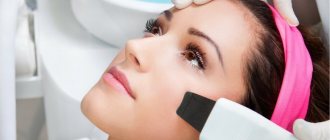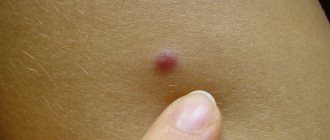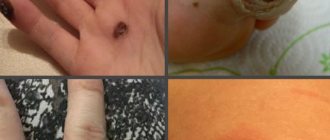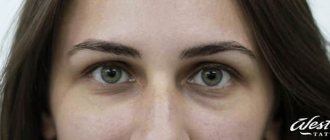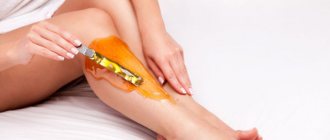The laser device leaves behind small wounds on the skin, which crust over over the next few hours. Noticeable swelling and redness may also occur, which is a completely normal reaction to laser photocoagulation. Typically, minor damage resulting from laser mole removal goes away within 2-4 weeks. How long the wound will take to heal is influenced by the size of the removed lesion, the technical features of the procedure, and the patient’s compliance with the prescribed standards.
Removing a mole takes a couple of minutes, but complete restoration of the skin will take at least a month.
How long should you not sunbathe after mole removal?
Within 14 days after laser removal of a mole, the epidermis forms under the scab. After the crust has fallen off, thin newly formed skin is visible at the removal site. The epidermis (surface layer) has not yet had time to accumulate melanin in the cells, a substance that protects our body from ultraviolet radiation. This means that this place becomes vulnerable and it is in this zone that processes of improper cell division can begin. Therefore, after laser removal of not only moles, but also other neoplasms or blood vessels on the skin, direct exposure to sunlight on this area should be avoided for at least 2 months. Or, while tanning, cover the areas with a fabric that reliably protects the area from the sun (cotton shirt and trousers).
What to do if it doesn’t disappear for a long time
The time it takes for wounds to heal at the site of the mole and for the crust to fall off is different for each patient. If the process takes too long, it is recommended to consult a doctor. The body may not cope with the restoration of the skin, this provokes gross defects and scars.
Only a specialist can conduct a detailed examination, a comprehensive diagnosis of the causes of prolonged healing after removal, and identify disorders in the immune system that lead to problems with epithelization of the wound surface.
There is no need to independently use wound healing agents, folk remedies, or biological additives to stimulate the regenerative process at the site of wounds or scabs. You can damage the skin, cause allergic reactions, and provoke suppuration of the wound surface due to intolerance to the drug.
Why you shouldn't sunbathe after mole removal
In the previous answer we partially answered the question. In the area of the epidermis that is not formed after laser removal, the risk of neoplasia (improper cell division) increases with the risk of developing cancer cells in the future. The second reason is the risk of age spots. The mechanism is almost the same. The weak, immature epidermis, trying to protect itself under the influence of sunlight, begins to actively produce the pigment melanin. This process goes faster than in nearby undamaged skin. Therefore, the intensity of skin coloring under the rays of the sun is different. A hyperpigmented area appears at the site where the mole was removed by laser.
How does laser mole removal work?
The procedure for removing moles is standard and includes several stages:
- Examination of the skin by a dermatologist to exclude the presence of signs of melanoma. There is a classification of 5 criteria for which the doctor must examine and check the formation. Shape, size, color, surrounding tissue, density. Sometimes dermatoscopy (examination of an element under multiple magnification) can be used for diagnosis. Having completely convinced that the formation is benign, the specialist begins the removal procedure itself.
- Consultation before the procedure. The dermatologist talks about how the procedure will take place and the symptoms that will accompany it. Possible complications and limitations that will occur after the manipulation.
- Signing the patient's informed consent for the administration of anesthetic and laser vaporization.
- Next, he proceeds directly to removing the mole. The area is treated with a skin antiseptic. An anesthetic injection is given. After complete freezing, the mole is removed within healthy tissue using a CO laser. Repeated treatment with a disinfecting solution is carried out.
- Recommendations for care.
Which doctor should I contact to remove a mole?
Laser mole removal is performed by a doctor who has been trained in the use of laser technology. Depending on the area of localization of the mole and its characteristics, the specialists to whom patients turn may be the following:
- dermatologist when placing the element on the torso, limbs, scalp;
- doctor - dermatocosmetologist if the formation is on the face, including other localizations;
- an oncologist if there is a large mole, or one that has recently increased in size or changed color;
- gynecologist when a tumor is located in the intimate area.
MOLES CANNOT BE REMOVED IF:
You are pregnant
I do not recommend removing moles during pregnancy for two reasons:
- All drugs from the group of local painkillers have pregnancy in the list of contraindications.
- In my experience, you are more likely to develop a scar during pregnancy.
This, of course, does not apply to situations where it is necessary to remove a mole for oncological reasons.
If you have a pacemaker
Radioknife and electrocoagulation are contraindicated. In such cases, removal should only be done with a laser or scalpel.
At the same time, there is evidence that many modern pacemakers do not respond to radio waves or electrical current. In any case, you must be informed that you have a pacemaker before any operation, regardless of its scope.
5. How many days does it take for a wound to heal after a mole is removed?
After removal, a dry crust remains on the skin. This is coagulated tissue. Underneath, healing and restoration of the skin begins to take place. After 7-10 days, this crust falls off on its own. Under no circumstances should you tear it off prematurely. The primary formed scar after the scab has fallen off is still different from the surrounding tissue. Regeneration processes continue in it and complete restoration of the structure ends by the 20th day. The area may still differ in color from the surrounding tissue, since the pigment accumulated in the cells is not equally distributed. But after a month it will be impossible to distinguish the place where the removal took place.
Treatment of removed nevus
Comprehensive wound care after mole removal includes:
- antiseptic treatment procedures;
- dressings;
- the use of ointments with antibiotics of a healing nature.
It usually takes 2-3 weeks for the wound to completely heal, but if the birthmark was large, it may take longer. When choosing products for treatment, it is better to consult a specialist. The dermatologist will recommend the most effective medications, taking into account the characteristics of the patient’s body.
Ointments and creams
There are various ointments, creams for treating and caring for the wound surface. Some have a wound-healing effect, others neutralize pathogenic flora. Most modern drugs have a complex effect.
Levomekol is a combination drug for local treatment of wounds. It has pronounced antibacterial, anti-inflammatory and wound-healing properties. Relieves pain, redness, swelling. The drug contains the antibiotic chloramphenicol and methyluracil, which improves tissue trophism. The medicine helps to carry out proper care after removing a problematic mole.
Thanks to its mild, gentle action, Levomekol can be applied to a wound. This is relevant if a bacterial infection has occurred and pus is released from the damaged area. In this case, it is recommended to warm it up to human body temperature. More often, a gauze bandage soaked in ointment is used to treat nevi. It is recommended to use the ointment within 4 days after the operation.
Contractubex belongs to a group of drugs that normalize the process of tissue regeneration. The gel contains liquid onion extract, allantoin, and sodium heparin. The product has antiproliferative, anti-inflammatory, antiallergic, and softening effects. The drug inhibits the growth of fibroblasts, suppressing non-physiological scar formation.
The product is used at the stage of scar formation to prevent the development of colloids. Treatment involves daily application of the gel to the problem area. Treatment can be carried out several times a day. For large areas of damage, you can smear it under a bandage after removing the mole, leaving it overnight.
For the treatment of wound surfaces the following may be prescribed:
- tetracycline ointment;
- Levosin;
- salicylic ointment;
- Agrosulfan;
- Solcoseryl;
- Dermazin;
- Baneocin;
- Vishnevsky ointment;
- Pantoderm;
- boric ointment;
- zinc or streptocidal ointment.
Before using any pharmaceutical product, you must consult a doctor, carefully study the instructions for the drug, and follow the recommendations of a dermatologist.
Potassium permanganate solution or Fukortsin
Antiseptic solutions are used to treat affected areas to prevent bacterial infections that will cause the sore to fester. The most popular disinfectants are potassium permanganate and Fukortsin.
Potassium permanganate or potassium permanganate is a crystalline powder, dark purple in color with a metallic sheen. Potassium permanganate is a strong oxidizing agent. Even when diluted in water, it has strong properties.
It is advisable to treat wounds with a permanganate solution of 0.1-0.5%. To do this, you need to count out 6-8 powder crystals. It is better to add the substance to warm water in a glass container. If you cannot determine the proportion, you can dilute the solution “by eye.” The color of the water after thorough mixing should be rich, like red wine.
Having prepared the solution, you can begin to treat the wound. To do this, dip a cotton swab into potassium permanganate and gently wipe the surface of the former mole. It is recommended to treat nearby skin areas. Carry out the procedure daily before applying a special cream.
Fukortsin is a ready-made solution of dark red color. After application, a characteristic pink color remains on the skin. The main effect of the drug is to disinfect wound surfaces and treat bacterial inflammation. Available in glass bottles. The use of Fukortsin is relevant during the healing of the wound surface of a removed nevus. During application, which should be carried out with a cotton swab, avoid contact with the mucous membranes of the body. It is advisable to carry out treatment 1–3 days before the problem area heals.
For treatment it is possible to use Chlorhexidine, Furacilin, brilliant green, chamomile infusion, hydrogen peroxide.
Bandage or patch
Plasters and dressings are the main attributes in the process of treating wound areas. Instead of the usual bandages and adhesive plaster, modern medicine uses special devices that protect the wound and promote speedy healing.
The Hydrocol Syn dressing is intended for the treatment of poorly healing wounds. Thanks to the properties of the special gel with which the cut is impregnated, exudate is absorbed and healing is stimulated. It does not allow water or bacterial pathogens to pass through. If there is exudate, the bandage is changed daily; if there is no discharge, it can be worn for several days.
Silicone patch Mepiform is intended for the resorption of hypertrophic and colloidal scars, which sometimes occur after healing of a wound from a birthmark. Available in small sections and large bandages, which can be cut if desired. The treatment period is long, taking up to 8 months.
Laser mole removal how to care
After laser mole removal, the following is recommended:
Immediately after removal, slight swelling and redness may be observed around the wound, which goes away within 1-3 days.
Take care of the crust that has formed after removal so that it does not fall off or tear off prematurely. It protects the wound from infection. Wear clothing that protects this area and do not scratch it.
If symptoms such as redness of the skin around the crust, swelling, pain, sanguineous or purulent discharge appear, immediately contact the clinic where the mole was removed with a laser .
While the crust protects the wound, there is no need to treat it with anything additional. After the scab has separated, to accelerate epithelization, you can apply a cream with dexpanthenol, solcoseryl, etc.
Follow the restrictions: solarium and insolation for up to 2 months; do not go to the bathhouse, sauna, or bath for 14 days; Avoid alcohol intake for the first 3 days; During the period until the scab falls off, cosmetics are not applied to this area.
Do I need to treat the wound with antiseptics or ointments?
Proper care, the use of anti-inflammatory, wound-healing, anti-scar agents promotes rapid restoration of damaged skin, prevents negative reactions, impaired epithelization, and the formation of hypertrophic scars.
We recommend reading
- What to do if a growth on a mole falls off
- What studies are carried out before removing a mole?
- Causes of watery moles
To treat a wound from a mole, the following medications are used:
- Antiseptic solutions to prevent the formation of secondary infections (Chlorhexidine, Miramistin).
- Creams, ointments with sunscreen filters to protect against burns and hyperpigmentation.
- Antibiotic ointments (Tetracycline, Levomekol) for suppuration and to accelerate regeneration.
- Anesthetic solutions, ointments with NSAIDs (Lidocaine spray, Diclofenac) to eliminate pain and inflammatory reactions.
- For itching, flaking of the skin - moisturizing, restructuring, anti-inflammatory liniments (Diprelife, Fastum-gel Traumeel-gel).
- Remedial drugs – Contractubex, Mederma, Actovegin. Used to stimulate regeneration and prevent scars.
The drugs should be used after consultation with your doctor.
Laser mole removal takes a long time to heal.
The healing time depends on the size of the mole, location, and individual characteristics of the regenerative processes.
If they are small in size, up to 0.5 cm, moles heal in 10-14 days; if they are larger than 1 cm, regeneration takes up to 3-4 weeks.
In places with good blood supply and in open areas of the body, healing is faster, up to 14 days. In places that are subject to friction (belt, bra line, groin area), get wet (perineum, armpits), have thick skin and poor blood flow (sole, palm), healing takes up to 4 weeks.


